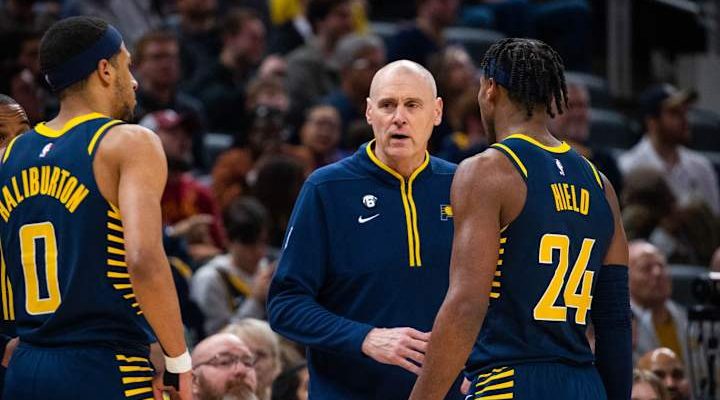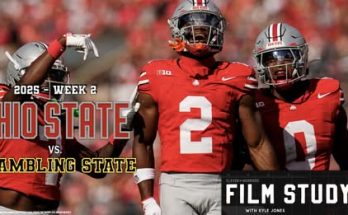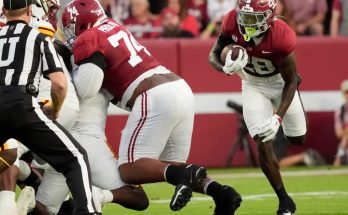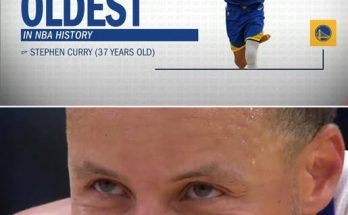The recent announcement that the Indiana Pacers have signed Taelon Peter to a two-way contract has sent ripples across the NBA fan base, particularly those with a keen eye for shooting talent. Peter, the 54th pick in the 2025 NBA Draft out of Liberty University, arrives with a reputation as an elite 3-point shooter, a commodity that has become increasingly valuable in the modern NBA.1 While a two-way deal signals a developmental path, the excitement surrounding his potential impact on the Pacers’ offensive scheme is palpable, sparking a wide range of reactions and discussions among fans and analysts alike.
The Indiana Pacers have, in recent years, cultivated an identity as a fast-paced, high-octane offensive team.2 Led by the dynamic playmaking of Tyrese Haliburton, their system thrives on spacing and efficient scoring.3 Last season, the Pacers showcased a potent offense, but even with their success, the quest for more consistent and diverse shooting threats remains a constant pursuit in the league’s ever-evolving landscape. The signing of Peter, even as a second-round pick on a two-way contract, speaks to this ongoing strategic focus. It’s a low-risk, high-reward move that aligns perfectly with the current NBA paradigm, where the 3-point shot is not just an option, but often the primary weapon.
The evolution of the 3-point shot in the NBA has been nothing short of revolutionary. Introduced in the 1979-80 season, it was initially viewed with skepticism by many traditionalists, considered by some as a “gimmick” borrowed from the flashier ABA. For decades, it remained a complementary piece of offensive strategy, primarily utilized by designated sharpshooters. However, the mid-2010s marked a significant turning point, often dubbed the “3-point revolution.” Teams, influenced by the success of innovative offenses like Mike D’Antoni’s Phoenix Suns and, more prominently, Stephen Curry and the Golden State Warriors, began to fully embrace and prioritize the long ball. This shift was driven by a fundamental understanding of offensive efficiency: a 3-pointer yields 50% more points than a 2-pointer, making it a more efficient shot per attempt.
The impact of elite 3-point shooting extends far beyond just the points themselves. It fundamentally alters court spacing, creating more room for drives, cuts, and post-ups. When a team possesses multiple credible threats from beyond the arc, defenses are forced to spread out, leaving the paint less congested and opening up passing lanes. This “floor stretching” effect is invaluable for playmakers like Haliburton, who thrive on having ample space to operate. It makes pick-and-rolls more dangerous, as defenders cannot easily “sag off” and clog the lane, and it allows for more dynamic off-ball movement, as defenders are forced to stick to their assignments on the perimeter. The statistical rise of 3-point attempts and efficiency across the league is a testament to this strategic shift. Teams are no longer just looking for shooters; they are actively seeking players who can consistently convert from deep, often prioritizing this skill set above traditional post-up ability or mid-range proficiency.
So, when news broke of the Pacers signing Taelon Peter, the immediate reaction from many fans was a mixture of curiosity and cautious optimism. On paper, Peter’s collegiate numbers are certainly intriguing. He averaged 13.7 points on an impressive 57.8% shooting from the field and a remarkable 45.3% from 3-point range last season at Liberty University.4 These are elite shooting percentages, especially for a guard. The “elite 3-point shooter” label isn’t just hyperbole; his college statistics suggest a genuine proficiency. Of course, the leap from college to the NBA is a significant one, and the efficiency typically drops, but the foundational skill is clearly there.
However, NBA Summer League provided a bit of a reality check. While Peter showcased flashes of his scoring ability, averaging 9.5 points, 2.2 rebounds, and 1.8 assists in 24 minutes, his 3-point shooting dipped to 26.7% (4-for-17). This stark difference between his collegiate numbers and his early Summer League performance is a common point of discussion among fans. Some are quick to dismiss the Summer League struggles, citing the different pace, increased athleticism, and often chaotic nature of those games. They argue that it’s a small sample size and that Peter’s proven college track record is a better indicator of his long-term potential. Others, however, view it with more caution, emphasizing that the NBA is a different beast and that consistent elite shooting at the next level requires more than just a smooth stroke; it demands quick decision-making, the ability to get shots off against longer, faster defenders, and the mental fortitude to perform under pressure.
The fan comments online, as always, offer a fascinating snapshot of the collective sentiment. The immediate reactions were overwhelmingly positive: “LETS GOOOII,” “It happened!”, “Stud,” “welcome mr peter.” These quick, enthusiastic responses highlight the inherent excitement that surrounds any new acquisition, especially one touted as an “elite shooter.” Pacers fans, having witnessed their team’s offensive prowess and also its occasional struggles to close out games due to lack of consistent perimeter shooting, are understandably eager for any addition that addresses this need. The notion of adding another knockdown shooter to complement Haliburton, Pascal Siakam, Myles Turner, and rising stars like Bennedict Mathurin and Andrew Nembhard is enticing.
Beyond the initial celebratory exclamations, deeper discussions emerged. Many fans immediately began to project Peter’s role within the existing Pacers roster. The question of how he fits into Rick Carlisle’s system is a recurring theme. Carlisle’s offenses have historically emphasized motion, ball movement, and exploiting mismatches, all of which are enhanced by strong perimeter shooting. Peter’s ability to play “without the ball, his shooting, his movement,” as described by Pacers general manager Chad Buchanan, suggests he could be an ideal fit for an offense that relies on off-ball screens, quick passes, and catch-and-shoot opportunities. In a system where Haliburton commands so much attention, a player who can knock down open threes effectively becomes a critical component, forcing defenses to make difficult choices.
Some fans are particularly excited about the prospect of Peter providing spacing for Haliburton’s drives and Siakam’s post-ups. As Andrew Nembhard demonstrated in the playoffs, where his 3-point shooting jumped significantly, having a secondary ball-handler or off-ball threat who can consistently hit from deep makes Haliburton’s job immensely easier. If Peter can replicate even a fraction of his collegiate shooting efficiency at the NBA level, it would create even wider lanes for Haliburton to penetrate and distribute, leading to more open looks for everyone. The thought of Peter, Mathurin, and Nembhard all being legitimate threats from deep alongside Haliburton’s passing vision is a tantalizing prospect for Pacers faithful.
However, the reality of a two-way contract also moderates expectations. For those less familiar with the nuances of NBA roster construction, a two-way deal means Peter will primarily spend his time with the Pacers’ G-League affiliate, the Noblesville Boom. This allows him to develop his game, adjust to the professional pace, and hone his skills without the immediate pressure of an NBA rotation spot. Fans who understand this aspect tempered their excitement with a dose of pragmatism. Comments like, “More on the Peter news. He will play for both the Pacers and their G-League affiliate the Noblesville Boom this coming season,” reflect this understanding. It’s a long-term play, a developmental project, rather than an immediate plug-and-play starter.
The Summer League struggles with his 3-point shot also fueled discussions about his overall game. While his collegiate shooting numbers were stellar, questions remain about his defense and playmaking, areas identified by observers as needing improvement. A true elite 3-point shooter in today’s NBA often needs to be more than just a specialist; they need to contribute defensively, be able to put the ball on the floor, and make smart reads. The G-League will be crucial for Peter to round out his game and demonstrate that he can be a well-rounded NBA player, not just a one-dimensional shooter. Fans are keen to see if he can develop these other facets of his game to become a consistent contributor at the highest level.
The discussion also inevitably veered into the Pacers’ broader strategic moves and team needs. The 2024-25 season saw the Pacers reach the NBA Finals for the first time since 2000, a significant achievement that has undoubtedly raised expectations. Despite this success, the team’s transactions column shows a dynamic roster with ongoing adjustments. The re-signing of Pascal Siakam was a massive priority, securing a key piece for the future. However, the loss of backup centers and injuries to other big men during the past season highlighted a need for depth in the frontcourt. While Peter addresses a different need, his signing is viewed as part of a larger, ongoing effort by the front office to optimize the roster for sustained success.
The debate among fans about the value of a second-round pick and a two-way contract in the grand scheme of an NBA Finals contender is also a common thread. Some argue that for a team with championship aspirations, every roster spot, even two-way spots, should be maximized with players who have clear paths to contributing. Others see it as smart asset management – finding potential gems in the later rounds of the draft and developing them within the organization. The Pacers have a history of developing talent, and the hope is that Peter can be another success story in that lineage.
The historical context of the Pacers’ shooting efficiency also adds an interesting layer to the fan discussions. While the team has often had strong offensive units, their 3-point shooting has had its ebbs and flows. The Reggie Miller era, for example, was defined by an iconic sharpshooter, but the league’s overall reliance on the three was far less pronounced. In the modern era, with players like Tyrese Haliburton, Myles Turner, and Pascal Siakam all demonstrating capable shooting, the addition of another specialist reinforces the team’s commitment to modern offensive principles. Aaron Nesmith’s impressive 45.4% from three last season (ranking second in the NBA) alongside other Pacers like Jarace Walker (40.5%), Pascal Siakam (39.7%), Myles Turner (38.6%), and Tyrese Haliburton (37.7%) all shooting efficiently from deep, speaks to the foundation already in place. Peter’s potential, if realized, would only amplify this strength, creating a truly formidable perimeter attack.
Ultimately, the excitement surrounding Taelon Peter’s signing, despite the two-way contract, reflects a deeper understanding among NBA fans of the game’s evolution. The 3-point shot is no longer a luxury; it’s a necessity. Teams that can consistently create and convert high-percentage looks from deep are the ones that dictate pace, control spacing, and ultimately win championships. The Pacers, fresh off an NBA Finals appearance, are clearly committed to building a roster that embodies these principles. Peter’s arrival, even if it’s a gradual process, is seen as another step in that direction.
The coming months will be crucial for Taelon Peter. His time with the Noblesville Boom will provide opportunities to refine his game, overcome the initial challenges of the professional circuit, and demonstrate that his elite shooting touch can translate consistently to the NBA. Fans will be eagerly watching his development, hoping that he can indeed become the sharpshooting specialist that the Pacers believe he can be, adding yet another dangerous weapon to an already potent offensive arsenal. The commentary from fans underscores not just an interest in the individual player, but a sophisticated understanding of the strategic importance of every piece on an NBA roster, especially in an era defined by the long ball. It’s a testament to the fact that in today’s NBA, even a 54th pick on a two-way deal can generate significant buzz and analytical discussion, all because of that coveted skill: the ability to shoot the lights out from beyond the arc.



